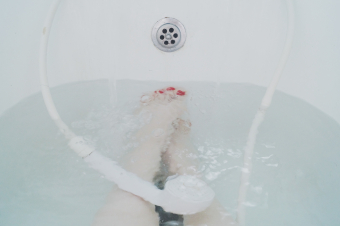In the dark and cold days of winter, there are few experiences as wonderful as jumping into a hot shower. This can change in an instant if your tank water heater encounters technical troubles.
If you familiarize yourself with the basic principles of how your tank water heater works, however, you will have the diagnostic tools to understand potential sources for problems. No one wants to be without hot water for long!
Today we will review the differences between an electric and a gas-powered tank water heater and common problems which can arise with a tank water heater.
Electric versus gas powered tanked water heaters
Both electric and gas water heaters use an insulated storage tank jacket. This steel jacket has enough insulation between the storage tank and tank jacket to reduce heat loss.
Electric water heaters are heated by electric upper and lower heating elements that extend into the water tank.
Gas water heaters have a gas burner, located behind a small metal viewing door, that heats the water below the tank. A flue (round chimney pipe) on the top of the water heater indicates that the water heater is gas. This flue is necessary to vent the exhaust to the outdoors from the water heater.
Where’s my hot water?
A tanked water heater can run out of hot water. This differs from a tankless water heater, which produces your hot water on-demand. The latter can be a more energy-efficient option for your household.
We guide you through selecting a tanked or a tankless water heater here. Our tankless water heater products offer some of the most effective and efficient performance available on the market. Read more here.
If someone in your household is showering and they run out of hot water, begin by adjusting the temperature dial on the front of the water heater.
Wait a few minutes and then check the water temperature at a faucet.
A tanked water heater which often lacks hot water for your household may be too small. It could also be due to an increase in water usage in your household. Check your shower heads and other appliances – what volume of water do they require to operate? What is your home water pressure set to?
Problems with little or no heat in your water may also be caused by a tripped power switch, failed heating element, or lack of tank maintenance.
These problems can be challenging to diagnose. Calling a licensed service provider, rather than tackling the problem on your own, can avoid the worsening of these issues or introduction of new problems.
For example, a poorly-functioning water heater may have a slow leak. This should be addressed promptly to avoid introducing dampness into your basement.
A water leak might be caused by leaking values, tank problems, and plumbing connections. Your tank might be suffering from a loose heating elements or tank corrosion. A corroded tank cannot be repaired and must be replaced. If you encounter this problem with your tank, you may want to consider the long-term financial benefits of switching to a tankless water heater.
It is a pleasure to be able to jump into a hot shower on a cold winter day. Technical troubles with your tank water heater can quickly change this joyful experience to a cold one.
Take some time to better understand how your tank water heater works and consider the benefits of a tankless water heater for your home water needs!






